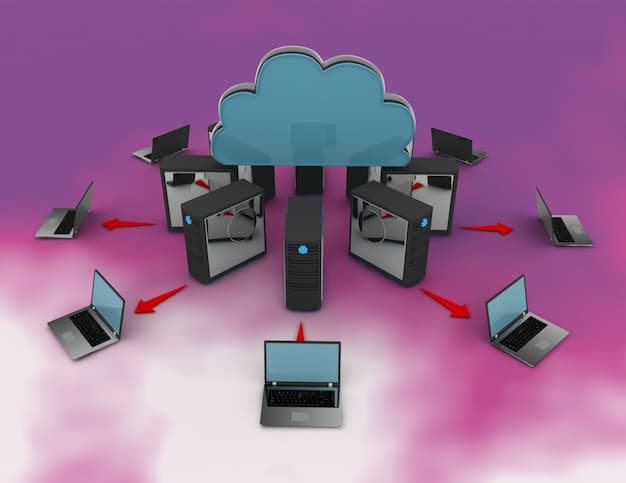Edge Computing: Revolutionizing Industries and Slashing Latency by 60%

Edge computing is rapidly transforming industries by processing data closer to the source, significantly reducing latency and enabling faster, more efficient operations in sectors ranging from healthcare to manufacturing.
The proliferation of IoT devices and the increasing demand for real-time data processing have fueled **the rise of edge computing: how it’s transforming industries and reducing latency by 60%**. This paradigm shift moves computation and data storage closer to the devices where data is generated, promising unprecedented speed and efficiency.
Understanding Edge Computing
Edge computing represents a significant departure from traditional cloud computing models. Instead of relying on centralized data centers, edge computing brings processing power closer to the devices that generate data. This proximity offers numerous advantages, particularly in reducing latency and improving real-time decision-making.
The Core Principles of Edge Computing
At its heart, edge computing is about decentralization and distribution. By processing data locally, it minimizes the need to transmit large volumes of information to distant servers, thereby reducing bottlenecks and improving overall system responsiveness.
Key Benefits of Edge Computing
The benefits of edge computing extend far beyond just reduced latency. It also enhances security, improves reliability, and enables new types of applications that were previously impossible with traditional cloud infrastructure.
- Reduced Latency: Processing data closer to the source minimizes delays.
- Enhanced Security: Local processing reduces the risk of data interception during transmission.
- Improved Reliability: Decentralized architecture ensures continued operation even if some components fail.
- New Applications: Enables real-time analytics, autonomous systems, and other innovative services.
In essence, edge computing is not just a technological advancement; it’s a fundamental shift in how we approach data processing and application deployment, paving the way for a more connected and responsive future.

Transforming Industries with Edge Computing
The impact of edge computing is being felt across a wide range of industries, from healthcare and manufacturing to transportation and retail. Its ability to deliver real-time insights and enable autonomous operations is revolutionizing how these sectors operate.
Healthcare: Real-Time Patient Monitoring
In healthcare, edge computing is enabling real-time patient monitoring, allowing doctors and nurses to respond quickly to critical changes in a patient’s condition. Wearable devices and IoT sensors can continuously collect vital signs, which are then processed locally to detect anomalies and trigger alerts.
Manufacturing: Predictive Maintenance
Edge computing is also transforming manufacturing by enabling predictive maintenance. By analyzing data from sensors on machines, manufacturers can identify potential failures before they occur, reducing downtime and improving efficiency.
Retail: Personalized Shopping Experiences
In the retail sector, edge computing is being used to create personalized shopping experiences. By processing data from cameras and sensors in stores, retailers can understand customer behavior and tailor promotions in real-time.
These are just a few examples of how edge computing is transforming industries. As the technology continues to evolve, we can expect to see even more innovative applications emerge, further blurring the lines between the physical and digital worlds.
Reducing Latency by 60%: A Closer Look
One of the most significant advantages of edge computing is its ability to reduce latency. By processing data closer to the source, it minimizes the time it takes for information to travel between devices and servers, resulting in faster response times.
The Impact of Latency Reduction
A 60% reduction in latency can have a profound impact on a wide range of applications. For example, in autonomous vehicles, it can mean the difference between a safe stop and a collision. In online gaming, it can provide a competitive edge by enabling faster reactions.
How Edge Computing Achieves Latency Reduction
Edge computing achieves latency reduction through several mechanisms, including:
- Proximity: Processing data closer to the source minimizes the distance data needs to travel.
- Local Processing: Performing computations locally reduces reliance on distant servers.
- Optimized Networks: Edge computing can also optimize network traffic by prioritizing critical data and reducing congestion.
By combining these strategies, edge computing can significantly reduce latency, enabling a new generation of real-time applications and services.

The Role of 5G in Edge Computing
The emergence of 5G technology is further accelerating the adoption of edge computing. 5G’s high bandwidth and low latency make it an ideal complement to edge infrastructure, enabling even faster and more reliable data processing.
5G and Edge: A Synergistic Relationship
5G provides the high-speed connectivity needed to support the massive data streams generated by IoT devices. Edge computing, in turn, provides the processing power needed to analyze this data in real-time.
Enabling New Possibilities
Together, 5G and edge computing are enabling a wide range of new possibilities, including:
- Enhanced Mobile Experiences: Faster download speeds and lower latency for mobile gaming and streaming.
- Smart Cities: Real-time traffic management, optimized energy consumption, and improved public safety.
- Industrial Automation: More efficient and reliable manufacturing processes.
Challenges of Implementation
Despite the potential benefits, implementing 5G and edge computing also presents some challenges. These include the need for new infrastructure investments, security concerns, and the complexity of managing distributed systems. However, as these challenges are addressed, we can expect to see even wider adoption of these technologies.
The synergy between 5G and edge computing is poised to unlock new levels of performance and innovation, driving the next wave of digital transformation across industries.
Security and Privacy Considerations
As edge computing becomes more widespread, security and privacy considerations are becoming increasingly important. The decentralized nature of edge infrastructure introduces new challenges in protecting data and preventing unauthorized access.
Addressing Security Challenges
To address these challenges, organizations need to implement robust security measures, including:
- Encryption: Protecting data both in transit and at rest.
- Access Controls: Limiting access to sensitive data to authorized personnel.
- Intrusion Detection: Monitoring edge devices for suspicious activity.
Privacy Compliance
In addition to security, organizations also need to comply with privacy regulations such as GDPR and CCPA. This includes obtaining consent from individuals before collecting and processing their data, and providing them with the right to access, correct, and delete their information.
By prioritizing security and privacy, organizations can build trust with their customers and ensure the responsible use of edge computing technology.
The Future of Edge Computing
The future of edge computing looks bright. As the number of IoT devices continues to grow and the demand for real-time data processing increases, edge computing will play an even more critical role in enabling a connected and intelligent world.
Emerging Trends
Some of the emerging trends in edge computing include:
- AI at the Edge: Integrating artificial intelligence algorithms into edge devices to enable more sophisticated local processing.
- Serverless Edge Computing: Using serverless computing models to simplify the deployment and management of edge applications.
- Edge-to-Edge Computing: Enabling direct communication and collaboration between edge devices.
These trends are expected to further enhance the capabilities of edge computing, making it an even more powerful tool for innovation and transformation.
Edge computing is not just a passing fad; it’s a fundamental shift in how we approach data processing and application deployment. As the technology continues to evolve, it will unlock new possibilities and drive unprecedented levels of efficiency and innovation across industries.
| Key Aspect | Brief Description |
|---|---|
| 🚀 Reduced Latency | Processes data closer to the source, minimizing delays. |
| 🛡️ Enhanced Security | Keeps more data local and reduces the risk of interception. |
| 🏭 Industrial Impact | Transforms manufacturing with predictive maintenance. |
| 📱 5G Synergy | 5G’s low latency enhances edge computing capabilities. |
Frequently Asked Questions
▼
Edge computing is a distributed computing framework that brings data storage and computation closer to the data source, which enhances speed and reduces latency for processing and delivering reliable data.
▼
By processing data near the source, edge computing minimizes the distance data travels to be processed. This reduces latency by cutting down the time data spends in transit to a central server.
▼
Numerous industries benefit from edge computing, including healthcare, manufacturing, retail, and transportation, by enabling real-time applications, improving data security, and enhancing operational efficiencies.
▼
5G technology enhances edge computing by providing faster and more reliable data transmission, which is essential for processing large volumes of data in real time at the edge of the network, enabling ultra-low latency applications.
▼
The dispersed nature of edge computing introduces security concerns related to data protection and the potential for unauthorized access. It necessitates strong encryption, robust access controls, and proactive intrusion detection systems.
Conclusion
As we’ve explored, **the rise of edge computing: how it’s transforming industries and reducing latency by 60%** signifies a monumental shift in how data is processed and utilized. By bringing computation closer to the data source, edge computing not only slashes latency but also enhances security, improves reliability, and unlocks a plethora of new applications across various sectors. With the ongoing advancements in 5G and AI, the future of edge computing promises even greater efficiency, innovation, and connectivity, paving the way for a truly intelligent and interconnected world.





